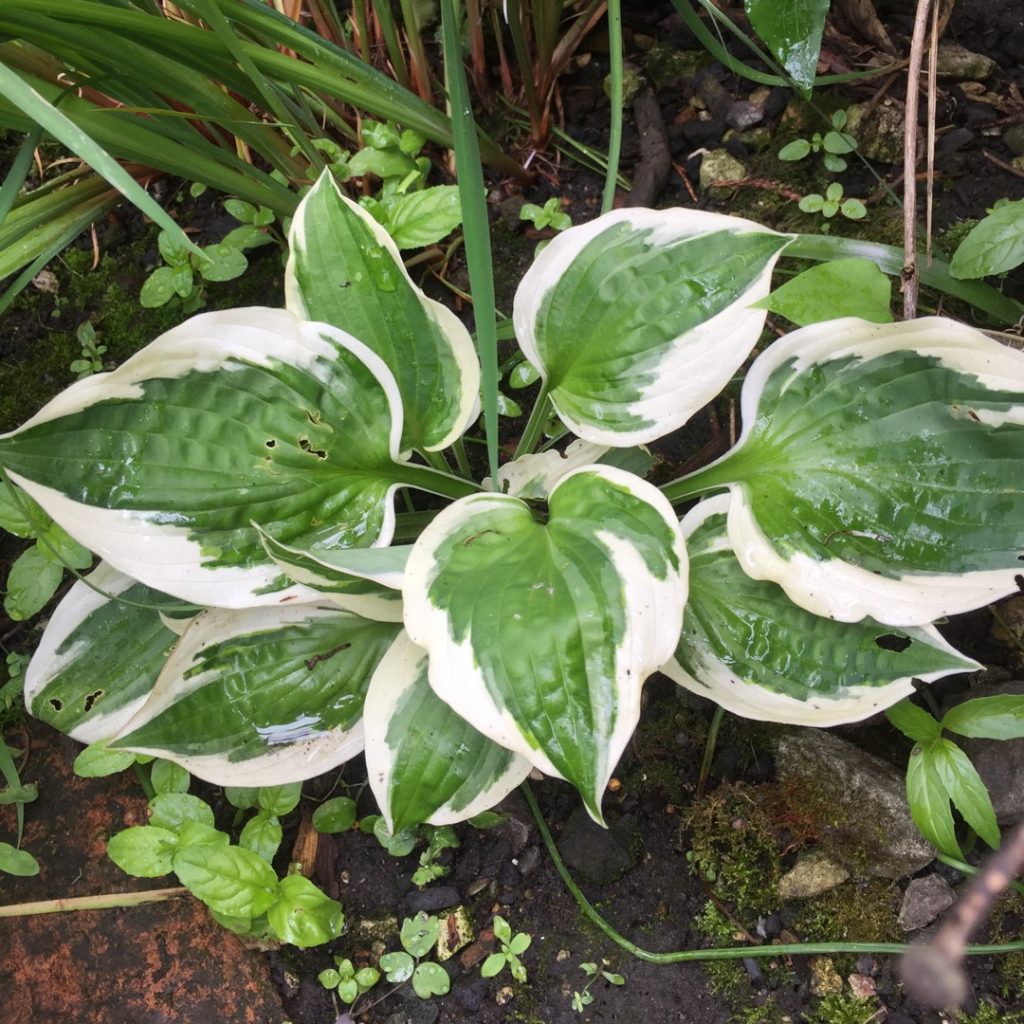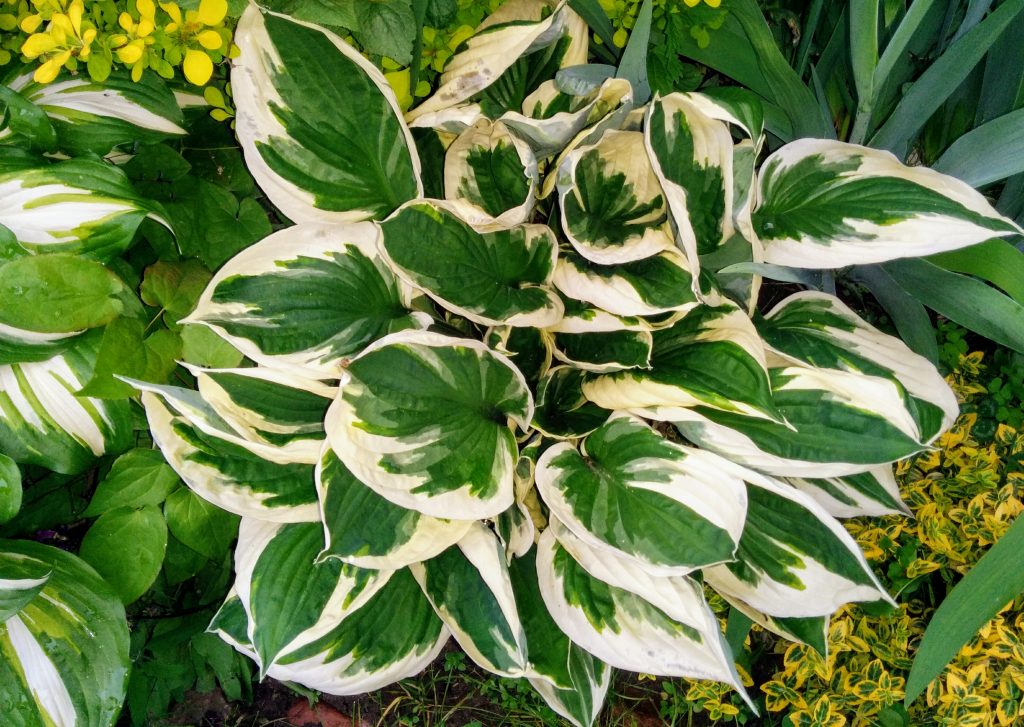Hosta Patriot - cultivation features
When arranging a personal plot, flower growers plant different plants; Hosta Patriot is considered one of the most popular. This decorative crop, originally from France, is valued for its variegated foliage and good frost resistance. Consider the main characteristics of the variety, planting and care rules.

Host patriot description
Description of the variety
The botanical name of the variety is hosta hybrida Patriot. The second name for hosts is function.
This perennial variety can be distinguished from other varieties by the following characteristics:
- the crown is dense, hemispherical, height about 70 cm;
- leaves develop on long petioles, basal, juicy, with a slightly corrugated surface, heart-shaped or round shape with a pointed tip, dark green color with white or beige edging;
- lavender flowers bloom on thin flower arrows, medium size (6 cm), thinning the pleasant aroma;
- in one racemose inflorescence, from 10 to 20 bell-shaped or funnel-shaped buds are formed.
Flowering lasts from early July to mid-August.
Landing features
You can buy seedlings of this variety at a gardening store or nursery. When choosing, pay attention to the condition of the roots and crown.
Buy healthy and strong specimens with a well-developed bud. The root system should be open without rot, mold or other signs of disease infection.
If the leaves are loose, it is better to refuse such a plant, since it has already begun the growing season and after transplanting it is unlikely to take root.
The plant is planted in the spring, when the last frosts have passed, or in early autumn - until mid-September. A shaded area with access to sunlight in the morning and evening hours is suitable.
Previously, the site is sprinkled with rotted manure or compost - a bucket of 1 m². If the soil is heavy, add 20 kg of sand or vermiculite to the same area.
Landing technology:
- They dig a hole slightly larger than the size of the roots.
- Fill in half with a nutrient mixture of peat, humus and sand mixed in equal amounts. the roots are lowered, straightened, covered with fertile soil to the top, tamped.
- It is important that the root collar remains above the surface of the soil, otherwise the plant will quickly rot and die.
- The seedling is watered with warm water, then mulched with peat (layer - 2-3 cm).
In group cultivation, a distance between the bushes of about 80 cm is observed.
Care requirements
The description of this decorative perennial includes simplicity in care, so every gardener, even a beginner, can grow it.

Hosta patriot reviews
Watering
Watering should be frequent and abundant. In the first month of life, the host is moistened every 4-5 days.
Then they are guided by the condition of the soil - if it has dried out to a depth of 4-5 cm, it's time to moisten.
Then the trunk circle is mulched so that the soil remains light and passes moisture and oxygen well. Weeds, plant residues are removed, and peat mulch is applied.
Top dressing
After two years of cultivation, the hybrid hosta patriot begins to be fed with mineral and organic dressings in turn. Dosage according to the instructions on the package. The power scheme is as follows:
- in early spring, before the leaves begin to bloom;
- in the budding phase;
- after the end of flowering.
All top dressing is combined with watering - this way the plant assimilates useful components faster and eliminates the risk of burning the roots.
Pruning
The plant does not need a shaping haircut, since it initially develops a compact and regular crown.
From spring to autumn, it is necessary to cut out non-viable parts - yellowed and dried leaves, broken flower stalks.
All manipulations are carried out using a sterile and sharp instrument. After pruning, they are irrigated with Epin or Zircon, which helps the plant recover faster.
Preparing for winter
Young bushes (up to three years old) have weak frost resistance, therefore, on the eve of autumn frosts, they are mulched with peat, the crown is sprinkled with fallen leaves or sawdust.
Mature plants do not need shelter. Before wintering, flower arrows are cut to the base, then the trunk circle is spud with peat or compost.
Reproduction methods
Gardeners successfully use several methods of breeding this crop. Subject to all the rules of planting and care, new seedlings root and take root perfectly.

Hosta fortune patriot description
Seeds
Freshly picked seeds are dried, mixed with sand, placed in a refrigerator or basement for stratification. They can be sown in a mixture of peat and sand to a depth of 1 cm, sprayed with warm water, covered with foil and put in a warm place.
Crops should be kept at a temperature of 22-25 ° C, they are provided with diffused daylight, they are ventilated and moistened every day (as the substrate dries out).
After about 2 weeks, greenery will appear on the surface of the earth. The shelter is removed, grown until the first pair of leaves develops, then planted in separate pots. They take care of them for another month, then they are planted in open ground.
The disadvantage of such cultivation is that the probability of obtaining a varietal plant is very low.
By dividing the bush
This propagation method is used for old plants that have stopped developing and need rejuvenation. In the spring, before the buds swell, the bush is watered abundantly, removed, washed off the remnants of the soil, dried.
Using a garden shovel or a sharp knife, the rhizome is divided into parts so that each has several roots, 2-3 petioles with leaves. Places of cuts are sprinkled with charcoal, seated separately.
By the kidney
This method is more practiced in industrial gardening, since it is problematic to create an optimal environment for the kidneys at home. They are germinated in test tubes under special temperature conditions, humidity and lighting.
Diseases and pests
The Patriot hosts have several diseases and pests that appear when the rules of care and planting are violated.

Hosta varieties patriot
Root collar rot
The main reasons are planting in a wetland, deepening of the root part. The leaves become discolored, die off, become soft, covered with a sticky bloom.
Such a plant is removed from the soil, all diseased leaves are cut off, the root system and the neck are treated with a fungicide. Then they are planted in a new place.
HVX virus
The main source of infection is infected purchased plants. Knowing all the signs of a viral sore, you will learn to distinguish strong seedlings from sick ones. On the leaf plate, spots, strokes, rings or dots are noticeable, located in a chaotic order. They are especially clearly visible in the light.
Over time, such a lesion leads to deformation of the leaves - they wrinkle, look dehydrated.
This disease cannot be treated, the plant is dug up and burned. The well is spilled with a strong solution of potassium permanganate or fungicide.
It is transmitted through the juice in the places of injury, therefore, when pruning, seating by dividing the root, you need to use a sterile tool, and after the procedures, irrigate all cut areas with a fungicide.
Slugs and snails
These are the most inveterate host pests. Insects gnaw tissue in the leaves. They leave silvery traces on the surface, which leads to the loss of the decorative effect of the plant.
To prevent the invasion of snails, you need to sprinkle the area with wood ash, tobacco dust, superphosphate and lime. You can also mulch the trunk circle of each bush with pine sawdust. Their smell scares off parasites.
Beer traps or pesticides are used against slugs and snails - Slug-eater, Thunderstorm.
Aphid
It settles on the inside of the leaves, feeds on their juice, which leads to yellowing, twisting and drying. In the fight against this parasite, at the initial stage of infection, tobacco infusion or ash-and-soap solution is used. If it does not help, pesticides are used - Karbofos or Actellik.
Landscape use
The perennial Patriot host has gained great popularity in landscaping different parts of the garden:

Hosta hybrid patriot
- it is planted singly in flower beds, along alleys, borders;
- combined with other ornamental vegetation - mosses, junipers, dwarf chrysanthemums, marigolds;
- the variegated perennial looks beautiful surrounded by monochromatic green hosta varieties;
- used in the design of rockeries, rock gardens, rabatok;
- planted next to gazebos, along fences, along with low-growing conifers - thuja, spruce and fir.
Testimonials
Gardeners have this variegated perennial in good standing and received many positive reviews:
- the plant does not need to be shaped, in adulthood it winters well without shelter - this greatly facilitates care;
- due to its good frost resistance and the ability to grow in a shaded place, it can be grown in different climatic zones;
- tolerates the neighborhood of other vegetation in the garden well, therefore it is used in the design of any compositions.

